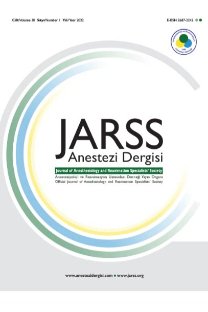Karsinoid Kalp Hastalığı Nedeniyle Triküspid Kapak Replasmanı Yapılan 14 Yaşındaki Erkek Çocuğunda Başarılı Anestezi Yönetimi
Successful Anesthetic Management of a 14 Year Old Boy Undergoing Tricuspid Valvular Surgery for Carcinoid Heart Disease
___
- Patel C, Mathur M, Escarcega RO, et al. Carcinoid heart disease: Current understanding and future directions. Am Heart J. 2014;167:789-95. https://doi.org/10.1016/j.ahj.2014.03.018
- Toby N, Weingarten TN, Abel MD, et al. Intraoperative Management of Patients with Carcinoid Heart Disease Having Valvular Surgery: A Review of One Hundred Consecutive Cases. Anesth Analg. 2007;105:1192-9. https://doi.org/10.1213/01.ane.0000284704.57806.0b
- Dobson R, Burgess MI, Pritchard DM, et al. The clinical presentation and management of carcinoid heart disease. International Journal of Cardiology. 2014;173:29- 32. https://doi.org/10.1016/j.ijcard.2014.02.037
- Suphathamwit A, Dhir A, Dobkowski W, et al. Successful hepatectomy using venovenous bypass in a patient with carcinoid heart disease and severe tricuspid regurgitation. J Cardiothorac Vasc Anesth. 2016;30:446- 51. https://doi.org/10.1053/j.jvca.2015.05.061
- Castillo JG, Filsoufi F, Adams DH, et al. Management of patients undergoing multivalvular surgery for carcinoid heart disease: the role of the anaesthetist. Br J Anaesth. 2008;101:618-26. https://doi.org/10.1093/bja/aen237
- Bouzas-Mosquera A, Crespo-Leiro MG, Paniagua MJ, et al. Adverse effects of mammalian target of rapamycin inhibitors during the postoperative period after cardiac transplantation. Trans Proc. 2008;40:3027-30. https://doi.org/10.1016/j.transproceed.2008.09.021
- Celik N, Cinaz P, Emeksiz HC, et al. Octreotide-Induced Long QT Syndrome in a Child with Congenital Hyperinsulinemia and a Novel Missense Mutation (p. Met115Val) in the ABCC8 Gene. Horm Res Paediatr. 2013;80:299-303. https://doi.org/10.1159/000354666
- ISSN: 1300-0578
- Yayın Aralığı: 4
- Başlangıç: 1993
- Yayıncı: Betül Kartal
İlkay BARAN, MENEKŞE OKŞAR, Savaş ALTINSOY
Eda BALCI, Aslıhan AYKUT, Aslı DEMİR, Ülkü SABUNCU, Rabia KOÇULU, Ümit KARADENİZ
Anesthetic Management of a Child with Cerebro-Oculo-Facio-Skeletal Syndrome
Alev ŞAYLAN, Nalan ÇELEBİ, Özgür CANBAY
Serebro-Okülo-Fasiyo-Skeletal Sendromlu Çocukta Anestezi Yönetimi
Nalan ÇELEBi, Alev ŞAYLAN, Özgür CANBAY
Hadi Ufuk YÖRÜKOĞLU, Yavuz GÜRKAN
Meta-Analysis: A Review Article
İLKER İNCE, Elif OZCİMEN, Alparslan TURAN
İlkay ERDOĞAN, Murat ÖZKAN, Pınar ZEYNELOĞLU, Aynur CAMKIRAN FIRAT
